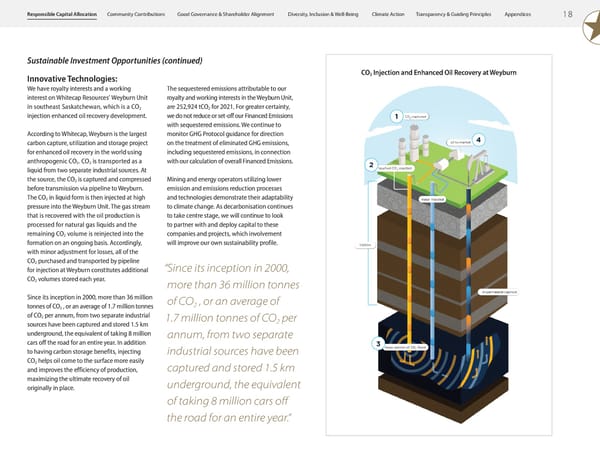Responsible Capital Allocation Community Contributions Good Governance & Shareholder Alignment Diversity, Inclusion & Well-Being Climate Action Transparency & Guiding Principles Appendices 18 Sustainable Investment Opportunities (continued) CO Injection and Enhanced Oil Recovery at Weyburn Innovative Technologies: 2 We have royalty interests and a working The sequestered emissions attributable to our interest on Whitecap Resources’ Weyburn Unit royalty and working interests in the Weyburn Unit, in southeast Saskatchewan, which is a CO are 252,924 tCO for 2021. For greater certainty, 2 2 injection enhanced oil recovery development. we do not reduce or set-off our Financed Emissions with sequestered emissions. We continue to According to Whitecap, Weyburn is the largest monitor GHG Protocol guidance for direction carbon capture, utilization and storage project on the treatment of eliminated GHG emissions, for enhanced oil recovery in the world using including sequestered emissions, in connection anthropogenic CO2. CO2 is transported as a with our calculation of overall Financed Emissions. liquid from two separate industrial sources. At the source, the CO is captured and compressed Mining and energy operators utilizing lower 2 before transmission via pipeline to Weyburn. emission and emissions reduction processes The CO in liquid form is then injected at high and technologies demonstrate their adaptability 2 pressure into the Weyburn Unit. The gas stream to climate change. As decarbonisation continues that is recovered with the oil production is to take centre stage, we will continue to look processed for natural gas liquids and the to partner with and deploy capital to these remaining CO volume is reinjected into the companies and projects, which involvement 2 formation on an ongoing basis. Accordingly, will improve our own sustainability profile. with minor adjustment for losses, all of the CO purchased and transported by pipeline 2 “Since its inception in 2000, for injection at Weyburn constitutes additional CO volumes stored each year. 2 more than 36 million tonnes Since its inception in 2000, more than 36 million of CO , or an average of tonnes of CO , or an average of 1.7 million tonnes 2 2 of CO per annum, from two separate industrial 2 1.7 million tonnes of CO per sources have been captured and stored 1.5 km 2 underground, the equivalent of taking 8 million annum, from two separate cars off the road for an entire year. In addition to having carbon storage benefits, injecting industrial sources have been CO helps oil come to the surface more easily 2 captured and stored 1.5 km and improves the efficiency of production, maximizing the ultimate recovery of oil underground, the equivalent originally in place. of taking 8 million cars off the road for an entire year.”
 2023 ESG Report | Franco-Nevada Page 19 Page 21
2023 ESG Report | Franco-Nevada Page 19 Page 21